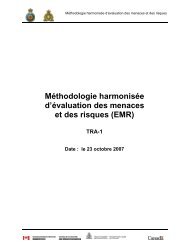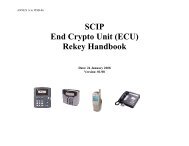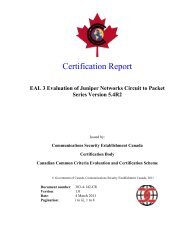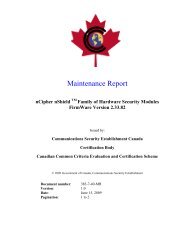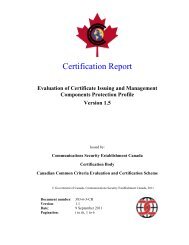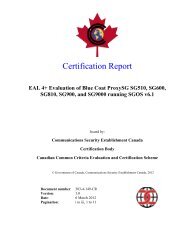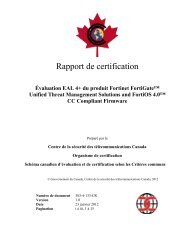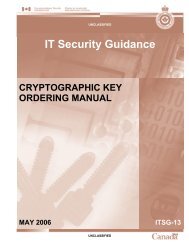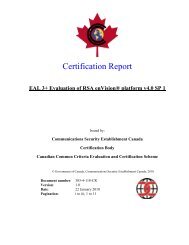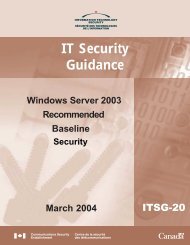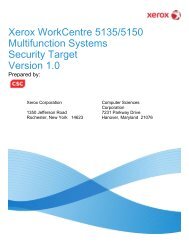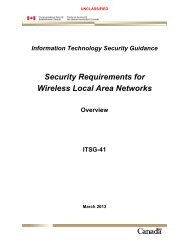Conseils sur l'utilisation du protocole TLS - Centre de la sécurité des ...
Conseils sur l'utilisation du protocole TLS - Centre de la sécurité des ...
Conseils sur l'utilisation du protocole TLS - Centre de la sécurité des ...
You also want an ePaper? Increase the reach of your titles
YUMPU automatically turns print PDFs into web optimized ePapers that Google loves.
November 2008 ITSB-60 novembre 2008<br />
The <strong>TLS</strong> standard does not mandate that the<br />
strongest avai<strong>la</strong>ble ciphers from the cipher suite<br />
or the strongest cryptographic parameters be<br />
used.<br />
The <strong>TLS</strong> record protocol phase breaks the<br />
message to be transmitted into fragments,<br />
optionally compresses the data, applies a MAC<br />
to the data to en<strong>sur</strong>e that the data is not<br />
tampered with, encrypts the data, and then<br />
transmits the data to the recipient. The recipient<br />
then <strong>de</strong>crypts the data, verifies the MAC,<br />
optionally <strong>de</strong>compresses, and reassembles the<br />
fragments to obtain the message.<br />
Recommendation<br />
Departments are strongly advised to adhere to<br />
the following CSEC security baselines when<br />
using <strong>TLS</strong> to protect Protected A and B<br />
information.<br />
CSEC does not approve the use of the SSL 3.0<br />
protocol. Any <strong>TLS</strong> client that supports SSL 3.0<br />
shall disable its use. While <strong>TLS</strong> 1.0 is approved<br />
by CSEC, the use of <strong>TLS</strong> 1.1 or higher is<br />
preferred. <strong>TLS</strong> 1.2 is currently in draft form<br />
and is going through the IETF standardization<br />
process.<br />
Only <strong>TLS</strong> clients that contain cryptographic<br />
mo<strong>du</strong>les that have been validated to Fe<strong>de</strong>ral<br />
Information Processing Standard (FIPS) 140-2<br />
un<strong>de</strong>r the Cryptographic Mo<strong>du</strong>le Validation<br />
Program (CMVP) shall be used. If the <strong>TLS</strong><br />
client also contains cryptographic algorithm<br />
implementations that are not validated un<strong>de</strong>r<br />
the Cryptographic Algorithm Validation<br />
Program (CAVP), the client shall be configured<br />
so that those implementations are not used.<br />
<strong>TLS</strong> clients being used for the protection of<br />
Protected A and B information shall<br />
d’établissement <strong>de</strong> liaison où le client envoie un<br />
certificat au serveur. Ce<strong>la</strong> permet alors d’authentifier<br />
le client.<br />
La norme <strong>TLS</strong> n’exige pas l’utilisation <strong>du</strong> chiffre le<br />
plus robuste <strong>de</strong> <strong>la</strong> suite ni <strong>de</strong>s paramètres<br />
cryptographiques les plus robustes.<br />
La phase <strong>du</strong> <strong>protocole</strong> d’enregistrement <strong>TLS</strong> divise le<br />
message à transmettre en fragments, comprime les<br />
données (en option), applique un MAC aux données<br />
afin <strong>de</strong> s’as<strong>sur</strong>er qu’elles ne sont pas altérées, les<br />
chiffre, puis les transmet au <strong>de</strong>stinataire. Le<br />
<strong>de</strong>stinataire déchiffre ensuite les données, vérifie le<br />
MAC, décomprime les fragments (en option) et les<br />
rassemble pour reconstituer le message.<br />
Recommandation<br />
Le CSTC recomman<strong>de</strong> fortement aux ministères <strong>de</strong><br />
prendre les me<strong>sur</strong>es <strong>de</strong> base suivantes en matière <strong>de</strong><br />
sécurité au moment d’utiliser le <strong>protocole</strong> <strong>TLS</strong> pour<br />
protéger les renseignements PROTÉGÉ A et<br />
PROTÉGÉ B.<br />
Le CSTC n’approuve pas l’utilisation <strong>du</strong> <strong>protocole</strong><br />
SSL 3.0. Tout client <strong>TLS</strong> qui prend en charge ce<br />
<strong>protocole</strong> doit le désactiver. Quoique le CSTC<br />
approuve l’utilisation <strong>du</strong> <strong>protocole</strong> <strong>TLS</strong> 1.0, il<br />
recomman<strong>de</strong> <strong>la</strong> version 1.1 ou une version supérieure.<br />
Le <strong>protocole</strong> <strong>TLS</strong> 1.2 a été soumis au processus <strong>de</strong><br />
normalisation <strong>de</strong> l’IETF et n’est disponible à l’heure<br />
actuelle qu’à l’état d’ébauche.<br />
Seuls les clients <strong>TLS</strong> qui contiennent <strong>de</strong>s mo<strong>du</strong>les<br />
cryptographiques validés au niveau <strong>de</strong> <strong>la</strong> Fe<strong>de</strong>ral<br />
Information Processing Standard (FIPS) 140-2 en<br />
vertu <strong>du</strong> Programme <strong>de</strong> validation <strong>de</strong>s mo<strong>du</strong>les<br />
cryptographiques (PVMC) doivent être utilisés. Si le<br />
client <strong>TLS</strong> contient également <strong>de</strong>s mises en oeuvre<br />
cryptographiques qui n’ont pas été validées en vertu<br />
<strong>du</strong> Cryptographic Algorithm Validation Program<br />
(CAVP), il faudra le configurer <strong>de</strong> sorte qu’il n’utilise<br />
pas ces mises en oeuvre.<br />
4



